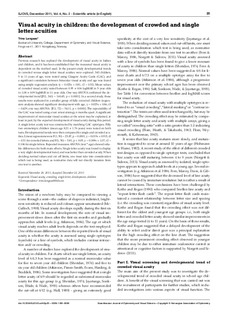| dc.description.abstract | Previous research has explored the development of visual acuity in babies and children, and it has been established that the measured visual acuity is dependent on the method used. In the present study developmental trends in crowded versus single letter visual acuities were explored. 343 children, 5 to 11 years of age, were tested using Glasgow Acuity Cards (GAC), and a significant correlation between binocular visual acuity and age was found using simple regression analysis (y = 0.023x + 0.81, r2 = 0.32). Mean values of crowded visual acuity varied between 0.95 ± 0.06 logMAR in 5-year-olds to 1.08 ± 0.09 logMAR in 11-year-olds. One way ANOVA confirmed the developmental trend [F(1, 341) = 160.45, p < 0.0001]. In a second study, these results were replicated in a smaller group of fully corrected children (regression analysis showed significant development with age, y = 0.025x + 0.86, r2 = 0.429, one way ANOVA: [F(1, 72) = 54.11, p < 0.0001]. The repeatability of the GAC was tested using a test-retest strategy, 6 months apart. A significant improvement of monocular visual acuities at the retest may be explained, at least in part, by the expected development of visual acuity during this period. A single letter acuity test was constructed by matching GAC optotypes. Fifty two emmetropic children (mean age 8.21 ± 1.76 years) were tested on both tests. Developmental trends were then compared for single and crowded acuities. Linear regressions were F(1, 50) = 23.87, p = 0.0001, y = 0.019x + 0.915, r2 = 0.31 for crowded letters and F(1, 50) = 5.81, p < 0.05, y = 0.009x + 1.07, r2 = 0.104 for single letters. Repeated measures ANOVA (test * age) showed reliable differences for both main effects. Single letter acuity was found to display a very slight developmental trend, and was better than crowded acuity. When deciding normal values and cut-off limits, one must take into consideration which test is being used, as normative data will not directly translate from one test to another. | no_NO |
